"A Summary of Meteorological Conditions Associated with Aircraft Icing and a Proposed Method of Selecting Design Criterions for Ice-Protection Equipment" 1
"the heat required for protection for this [severest] situation is several times that required for the most probable icing condition."
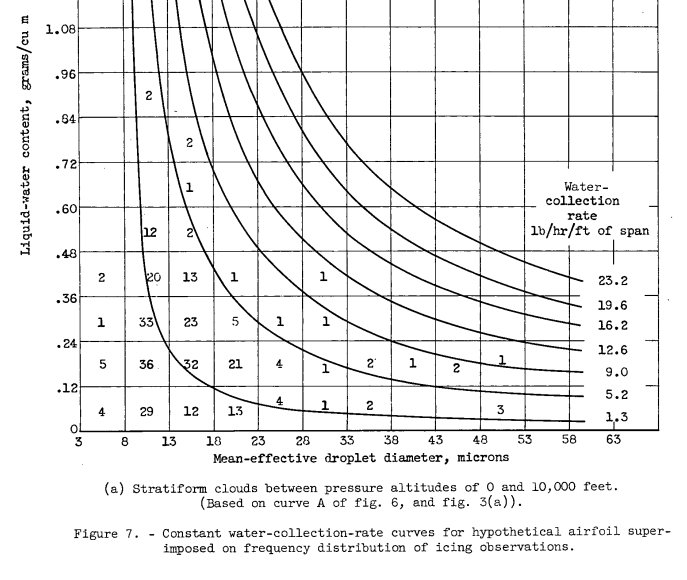
Summary
By allowing some ice to accumulate in severe icing conditions, the peak energy requirements for ice protection can be reduced.
Key Points
- The altitude and temperature boundaries for Continuous Maximum Icing are establish that are later used in Appendix C.
- "A total of 305 traverses of cumuliform clouds by P-61C airplanes were made in icing conditions, and on no occasion did ice accumulate before the end of a traverse to such an extent as to make safe flight impossible."
- "the heat required for protection for this [severest] situation is several times that required for the most probable icing condition."
- "Ice-protection equipment for some critical aircraft components, such as turbine-engine inlets, should, however, be designed for approximately the severest ice-collection rates expected."
Abstract
Data from various sources on the observed values of meteorological variables, liquid-water content, mean-effective droplet size, and temperature, which are pertinent to aircraft icing, are summarized; and a method is proposed for the selection of design criterions for ice-protection equipment.
The data are divided according to two broad cloud types, namely, stratiform and cumuliform clouds, because the physical dimensions, the formation and development processes, the frequency of encounter, and the severity of icing conditions are very different for the two cloud types. The data are summarized in such a manner as to give the frequency of occurrence of observed icing conditions according to two of the pertinent meteorological variables. The summarized data indicate that statistical relations exist between liquid-water content, mean-effective droplet diameter, temperature, and pressure altitude.
The proposed method of selecting values of liquid-water content and mean-effective droplet diameter as design criterions for ice-protection equipment is based upon the collection efficiency of an airfoil as a function of droplet size and the frequency of occurrence of icing situations with various liquid-water-contents and mean-effective droplet diameters. The method provides a convenient means of calculating the percentage of icing encounters in which the water-collection rate exceeds the design rate for the ice-protection equipment and also illustrates the desirability of sometimes designing ice-protection equipment for water-collection rates which are less than the maximum rate expected. The method is illustrated by the selection of design criterions for ice-protection equipment for a hypothetical, 12-percent thick, low-drag airfoil with a chord length of 15.8 feet; however, the method may be employed for any airfoil provided the collection efficiency is known.
Discussion
This is a fairly long publication (33 pages). For brevity, only the comments about icing in stratiform clouds will be detailed.
INTRODUCTION
For several years research has been conducted on the prevention and removal of ice formations caused by supercooled clouds on components of aircraft by the addition of heat to the vulnerable components. In order to evaluate the heat requirements of an ice-prevention system that provides adequate protection against icing caused by supercooled clouds, the rate at which supercooled liquid cloud droplets are collected by each portion of the surface of the airplane, the probable maximum duration, and the frequency of occurrence of various icing conditions must be known. The evaluation of these unknowns requires the following information about supercooled clouds:
(1) liquid-water content,
(2) droplet diameter and droplet-size distribution,
(3) air temperature and pressure,
(4) horizontal and vertical extent of icing situations, and
(5) frequency of occurrence of icing conditions of a given description.Incomplete information concerning the fundamental physical processes that determine the structure of clouds and cloud systems has necessitated an experimental and statistical approach to the definition of the important features of an icing cloud. Flights have been made by the NACA and other agencies with instrumented aircraft through supercooled clouds for the past several years in order to establish, for the pertinent meteorological variables, the range of values encountered in icing conditions. As a result of these instrumented flights, a considerable accumulation of meteorological data pertinent to the icing problem has been obtained and published.
As part of the NACA Lewis laboratory icing-research program, this report summarizes the existing meteorological data from various sources and proposes a method of selecting design criterions for ice-protection equipment. The data are summarized in such a manner as to give the frequency of occurrence of icing situations with a given combination of two of the principal meteorological variables. These frequencies of occurrence are used in combination with water-collection rates for an aircraft component as a basis for the proposed method of selecting design criterions for ice-protection equipment. This method gives a convenient means of determining the percentage of icing encounters in which the water-collection rate exceeds the collection rate for which the ice-protection system is designed. The method is illustrated by the selection of design criterions for ice-protection equipment for a hypothetical, 12-percent thick, low-drag airfoil with a chord length of 15.8 feet.
Cloud Droplet Diameter as Function of Pressure Altitude
A component or an airfoil of an aircraft in flight through a cloud usually does not intercept all the droplets in its path, because some of the droplets are deflected around the airfoil by the air flow. The percentage of droplets intercepted depends on; among other factors, the droplet size and increases with increasing droplet size if all other factors are constant. Because the percentage catch, and therefore the rate of ice accumulation, are functions of droplet size, any relation between droplet size and pressure altitude is of importance, for possibly the altitude of severest aircraft icing would not coincide with the altitude of maximum liquid-water content indicated by figure 1.
Data collected during icing survey flights indicate that cloud droplets in a given icing situation are not always uniform in size but may be distributed over a wide range of sizes. Because the droplet-size distribution may influence the rate of ice accumulation on various areas of an airfoil, it should be employed in the design calculations for ice-protection equipment. The introduction of this factor, however, greatly complicates the design calculations; therefore it has not been used extensively. The mean-effective droplet diameter has been employed instead. Furthermore, some doubt exists as to the validity of the droplet-size distribution measurements.
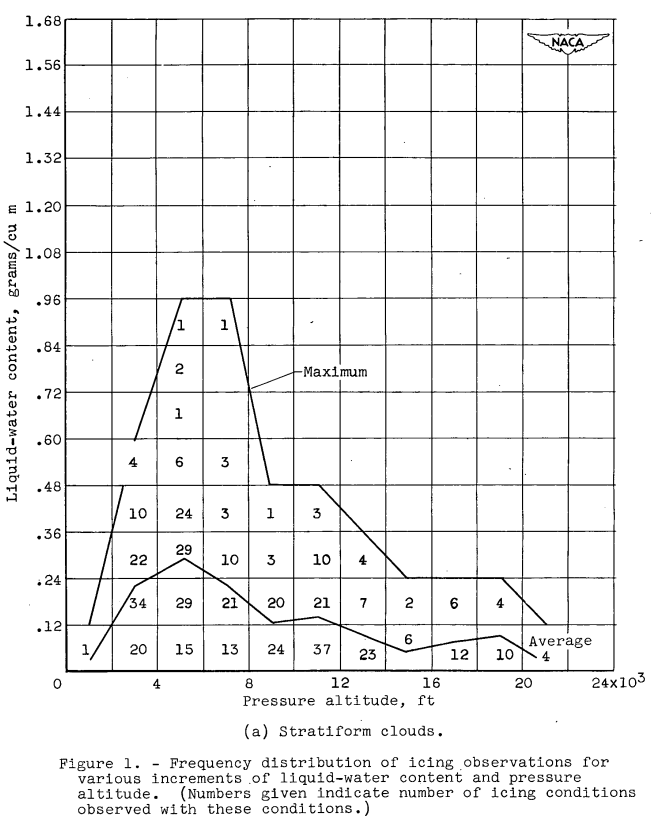
Bivariate frequency-distribution charts of mean-effective droplet diameter as a function of pressure altitude for icing conditions in stratiform and cumuliform clouds with curves of maximum and average values of mean-effective droplet diameter are presented in figures 2(a) and 2(b). If the one observation in the altitude range 0 to 2000 feet in stratiform clouds (fig. 2(a)) is regarded as insufficient data for average-mean-effective-droplet-diameter calculations, then the average and maximum values of mean-effective droplet diameter are very similar for the two cloud types. The average value of mean-effective droplet diameter for any given altitude for cumuliform clouds is in general from 1 to 4 microns larger than for stratiform clouds. For both cloud types the over-all average mean-effective droplet diameter is higher in the pressure-altitude range of 10,000 to 20,000 feet than in the range of 0 to 10,000 feet.
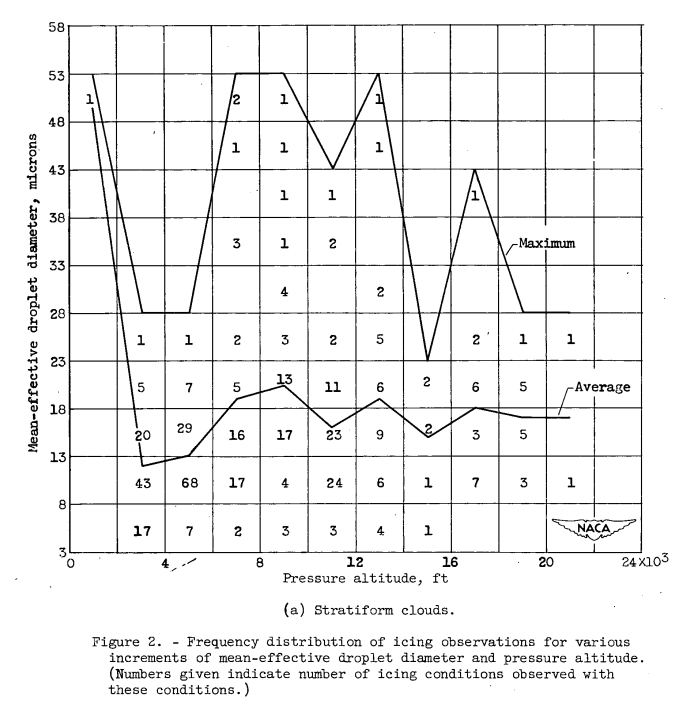
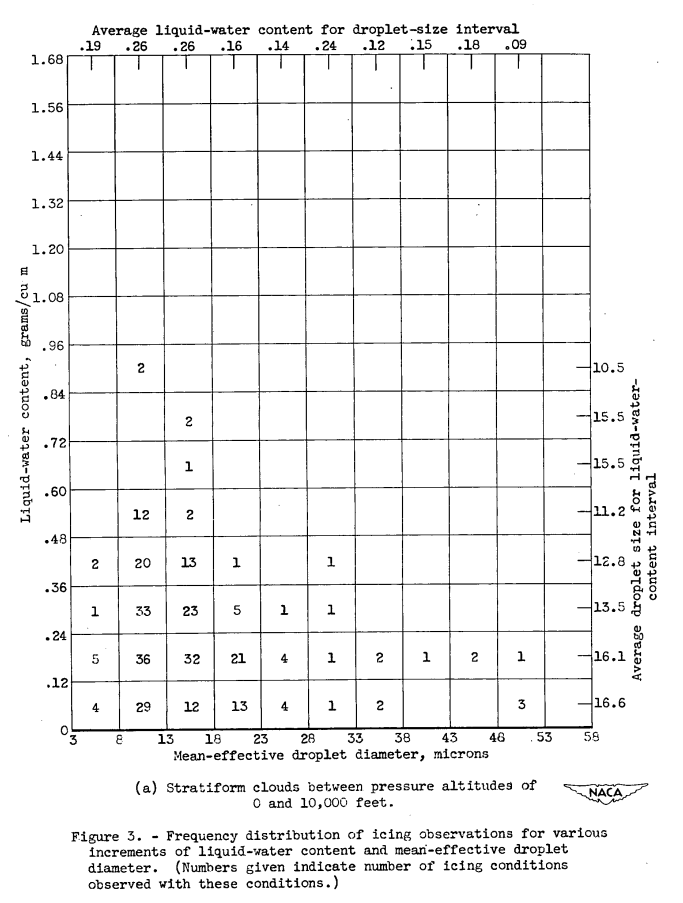
SELECTION OF METEOROLOGICAL FACTORS FOR ICE-PROTECTION-SYSTEM DESIGN
Because the amount of heat required by ice-protection systems of high-speed jet aircraft to evaporate all the intercepted supercooled water from the vulnerable components is often very large, it may be necessary to design ice-protection equipment for some components for icing conditions of less severity than the maximum expected in order to keep the heat requirements to acceptable values. This may be particularly necessary if the probability of encountering the severest icing condition is very low and the heat required for protection for this situation is several times that required for the most probable icing condition.
This approach to ice-protection equipment design may be feasible, because severe icing situations are usually those with high liquid-water content and therefore generally of short horizontal extent (fig. 5); and some components with high heat requirements, such as wings, can often tolerate small accumulations of ice for short periods of tine without excessive airplane performance losses. Data obtained during the recent Thunderstorm Project (reference 10) on icing conditions in cumuliform clouds is of interest in this connection. A total of 305 traverses of cumuliform clouds by P-61C airplanes were made in icing conditions, and on no occasion did ice accumulate before the end of a traverse to such an extent as to make safe flight impossible. Inasmuch as these flights were made with relatively slow airplanes with reciprocating engines, no direct conclusions can be drawn from these flights regarding safety of flight through cumuliform clouds with high liquid-water content by jet-powered aircraft other than that it may be possible to fly in icing conditions which will overload the ice-protection system for short periods of time without loss of control before emerging into clear air or less severe icing conditions. For jet-powered aircraft with thin high-speed wings, the amount of ice that can be tolerated may be considerably less than that for low-speed wings. In addition, critical components such as turbine-engine inlets must be kept ice free at all times; and ice-protection equipment for these components must be designed to cope with the maximum icing conditions anticipated. In general, these critical areas do not require a large percentage of the total heat requirements.

The boundaries implied on Figure 4 eventually become the boundaries of Continuous Maximum Icing in Figure 2 of Appendix C 2. Note that NACA-TN-2569 is cited on the figure:

Extent of Icing Condition
Although data on horizontal and vertical extent of icing conditions are limited, sufficient data have been obtained to indicate the order of magnitude of these icing variables. The maximum horizontal extent of icing situations with a given average liquid-water content is presented in figure 5. The dashed curve is an estimate of the probable maximum horizontal extent of winter icing situations with a given average, liquid-water content as proposed in reference 5. The solid curve is an envelope of the maximum distance flown in icing conditions with a given average liquid-water content, as measured and reported by reference 4, for 57 flights in icing conditions during four winter icing seasons from 1946 to 1950. The curves of figure 5 are similar and show an inverse relation between average liquid-water content and maximum horizontal extent of icing situations. The majority of observations on which the estimated curve is based were taken in cumuliform clouds, whereas a large majority of observations on which the measured curve is based were in stratiform clouds. This difference probably accounts for the higher liquid-water content indicated for short distances by the estimated curve, as the liquid-water content is usually higher in cumuliform clouds than stratiform clouds.
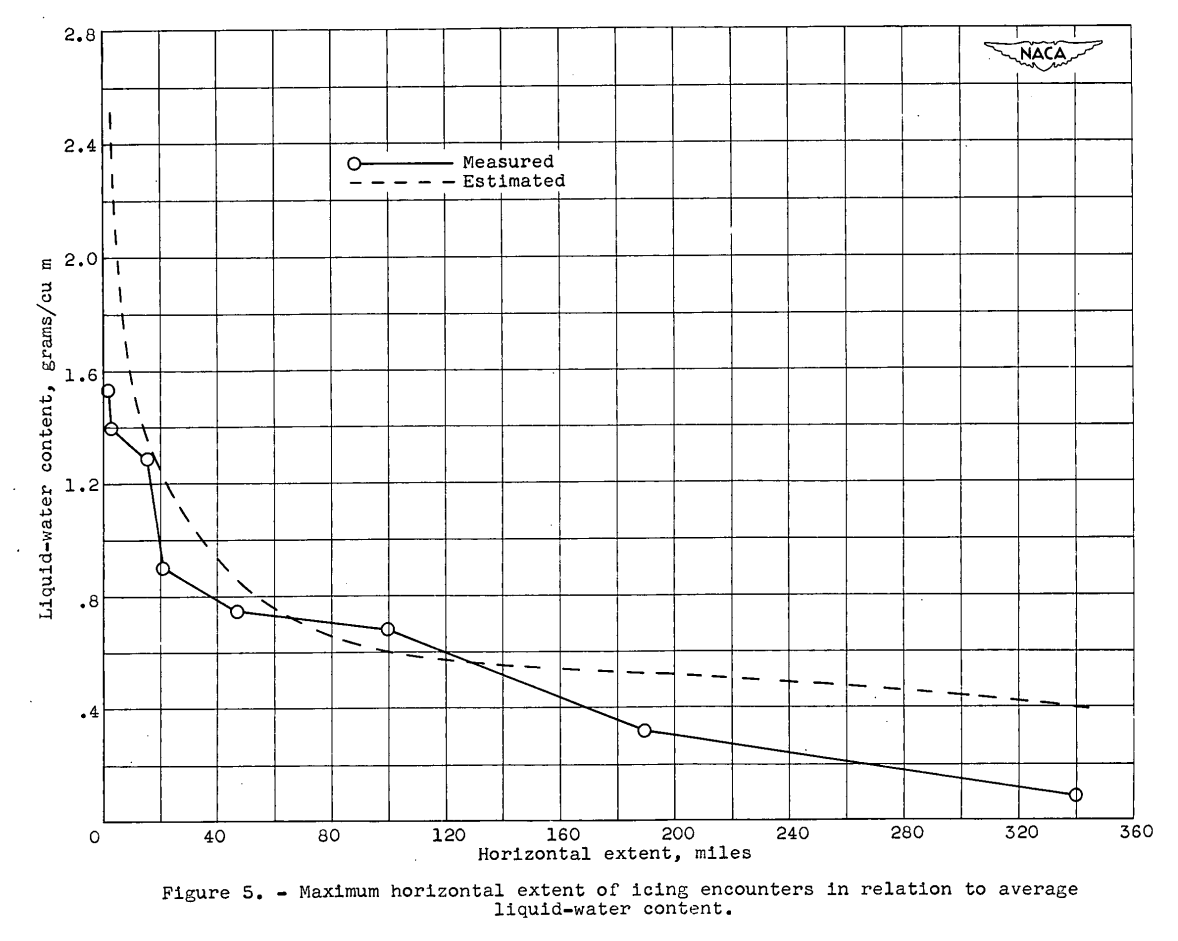
Reference 4 is NACA-TN-2306. Reference 5 is NACA-TN-1393. One may note that the "Measured" data in Figure 5 is the same as "Envelope of maximum..." in Figure 2 of NACA-TN-2306.
SELECTION OF METEOROLOGICAL FACTORS FOR ICE-PROTECTION-SYSTEM DESIGN
Because the amount of heat required by ice-protection systems of high-speed jet aircraft to evaporate all the intercepted supercooled water from the vulnerable components is often very large, it may be necessary to design ice-protection equipment for some components for icing conditions of less severity than the maximum expected in order to keep the heat requirements to acceptable values. This may be particularly necessary if the probability of encountering the severest icing condition is very low and the heat required for protection for this situation is several times that required for the most probable icing condition.
In order to evaluate the rate of water interception by a component, the collection efficiency of the component must be known. The collection efficiency of an airfoil, defined as the ratio of the water intercepted by the component to the total mass of water in the volume swept out by the moving airfoil at zero geometric angle of attack, is a function of the physical dimensions of the airfoil, the airspeed, and the angle of attack as well as the meteorological variables: droplet size, air temperature, and pressure. The air temperature and pressure enter into the relation indirectly as parameters determining the viscosity and density of the air. The collection efficiency of an airfoil can be obtained, from droplet trajectory calculations such as those presented in reference 11.
This approach to the design of ice-protection equipment can best be presented by means of an example. Assume that the probability of encountering an icing situation with a given rate of water interception is desired for a hypothetical, 12-percent thick, low-drag airfoil with a chord length of 15.8 feet for a climb condition from 0 to 20,000 feet at 350 miles per hour. Estimates of the collection efficiency as a function of droplet size for such a hypothetical airfoil for two operating and meteorological conditions are presented in figure 6.
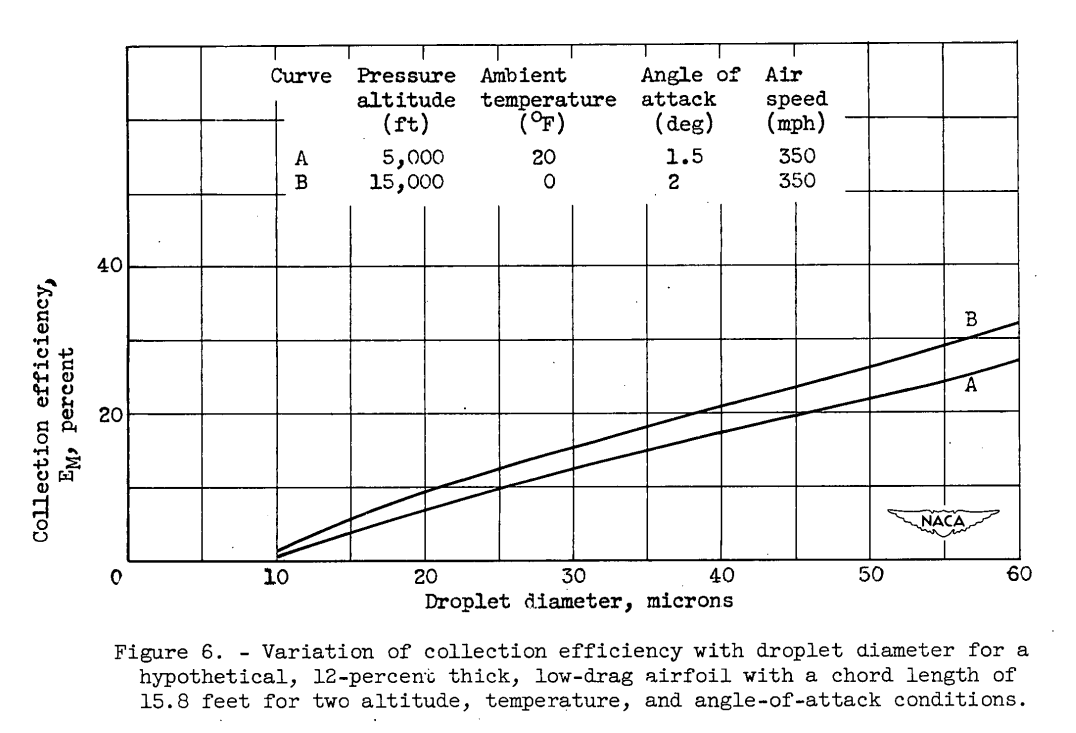
Curves of constant water-collection rates as functions of liquid-water content and droplet size for the two pressure-altitude ranges of the two cloud types are shown in figure 7. These curves are superimposed upon the data of figure 3. The percentage of icing encounters with water-collection rates less than a given value for a given cloud type and pressure-altitude range is given by the ratio of the sum of the icing encounters in the region below and to the left of a given water-collection-rate curve to the total number of icing encounters for the given cloud type and pressure-altitude range.
Cumulative frequency curves of the percentage of icing encounters with rates of water collection less than a given value for the four cloud classifications of figure 7 obtained in the preceding manner are presented in figure 8. The water-collection rate increases very rapidly above 90 percent of all encounters. It may therefore be desirable to exploit the tolerance of various components to small quantities of ice accumulations and the small frequency of occurrence of severe icing conditions in order to keep the heat requirements to acceptable values. A comparison of the cumulative frequency curves for stratiform clouds (figs. 8(a) and 8(c)) with those for cumuliform clouds (figs. 8(b) and 8(d)) shows that an ice-protection system designed for a given water-collection rate will provide a much higher percentage of protection for flights in icing conditions in stratiform clouds than in cumuliform clouds. However, if only 5 percent of all icing encounters during routine flight operation occur in cumuliform clouds (reference 9), then the probability of encountering an icing situation during routine flight with a water-collection rate higher than the design rate is only slightly higher than that calculated for icing encounters for stratiform clouds alone.

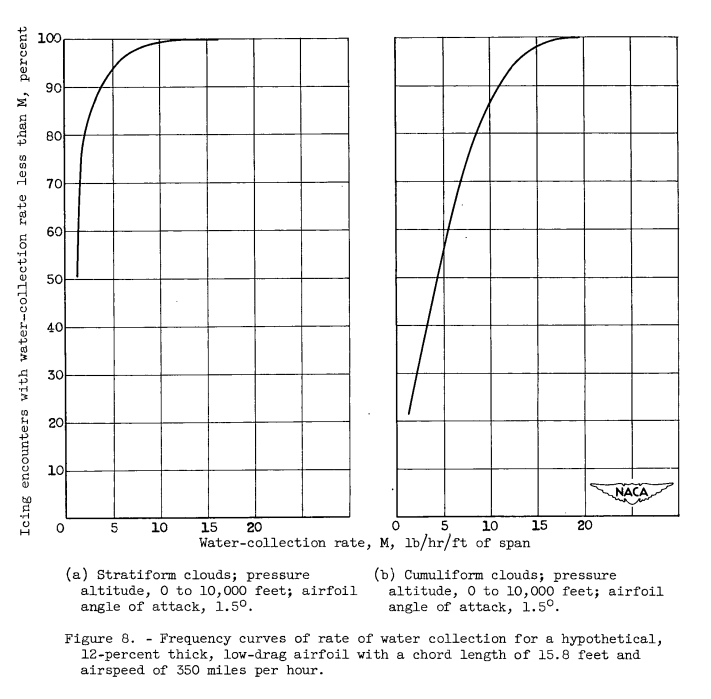
Conclusions
CONCLUDING REMARKS
Data on the range of values of the meteorological variables pertinent to the aircraft icing problem have been summarized and a method has been proposed for the selection of design criterions for ice-protection equipment of the continuous heat type that evaporates the intercepted water. The summarized data indicate that statistical relations exist between liquid-water content, mean-effective droplet diameter, temperature, and pressure altitude. Therefore, when electing values of these parameters as design values, caution should be exercised because individual values of these parameters could be selected that, when considered alone, appear to be reasonable, but would occur very seldom in combination in an icing situation.
The proposed method of selecting design criterions is based upon the collection efficiency of the airfoil as a function of droplet size and the frequency of occurrence of icing situations with various liquid-water, contents and mean-effective droplet sizes. The method provides a convenient means of calculating the percentage of icing encounters in which the ice-collection rate exceeds the design rate for the ice-protection equipment. The method also illustrates the desirability of exploiting the tolerance of various components to small quantities of ice accumulations, because the frequency of encounter of icing situations with extremely high ice-collection rates is low. Ice-protection equipment for some critical aircraft components, such as turbine-engine inlets, should, however, be designed for approximately the severest ice-collection rates expected. For airplanes equipped with ice-protection equipment which is designed for ice-collection rates less than the maximum expected, meteorological forecasting and navigation will have to be employed to avoid the extreme conditions or the aircraft will have to be operated on the assumption that the ice-protection equipment for the noncritical components can be overloaded for a short time until the aircraft emerges into clear air or less severe conditions.
Citations
NACA-TN-2569 is one of the three NACA publications cited directly in Appendix C of the FAA icing regulations, part 25 2.
An online search (scholar.google.com) found 45 citations for NACA-TN-2529.
Notes
-
Hacker, Paul T., and Dorsch, Robert G.: A Summary of Meteorological Conditions Associated with Aircraft Icing and a Proposed Method of Selecting Design Criterions for Ice-Protection Equipment. NACA-TN-2569, 1951. ntrs.nasa.gov ↩